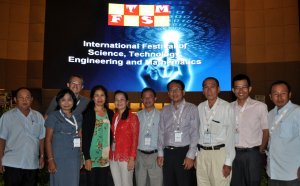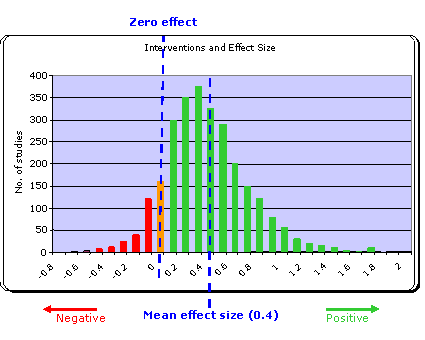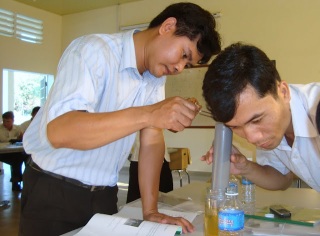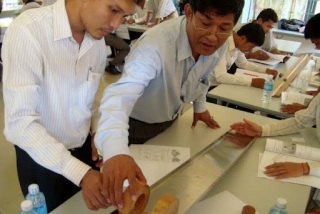
Interesting article in The Guardian (from some time ago, I’m a slow reader) about the overblown importance attributed to doing experiments during science lessons.
The article reminds me of my experience in Cambodia, where experiments are also frequently espoused as proof of a student-centred lesson. In reality experiments in Cambodian classrooms are often a very teacher-centred activity:
- the teacher demonstrates and students (at best) trying to observe what happens.
- students do the experiment in large groups, by adhering to a strict series of steps outlined in a worksheet.
- students work in large groups, in which usually only one or two students do the work, The others are merely bystanders.
- the procedure, observations and interpretation of the experiment are laid down in detail beforehand.
The article touches upon two interesting elements. First, there is the questionable educational value of many experiments in science classes. secondly, there is the challenge to measure lesson quality beyond ‘ticking off’ the occurrence of activities such as experiments.
The article refers to ‘The Fallacy of Induction‘ from Rosalind Driver. Her book ‘Making Sense of Secondary Science’ is an excellent book on misconceptions in science education and has been an important inspiration for me.
“Driver doesn’t dismiss practical work in science, but argues that ‘Many pupils do not know the purpose of practical activity, thinking that they ‘do experiments’ in school to see if something works, rather than to reflect on how a theory can explain observations.” (Driver et al, 1993, p.7).
She raises two main arguments. First, practical activities are often presented to students as a simulation of ‘how science really works’, collecting data, making observations, drawing inferences and arriving at a conclusion which is the accepted explanation. It’s simplistic, and pupils happily play along, following the ‘recipe’ in the ‘cookbook’, checking whether they have ‘the right answer’. In
reality, science rarely works this way:
“For a long time philosophers of science and scientists themselves have recognised the limitations of the inductive position and have acknowledged the important role that imagination plays in the construction of scientific theories.” (Driver, 1994, p.43)
The second argument is that pupils don’t arrive in class with a blank slate, but with a whole range of self-constructed interpretations or ‘theories’ on how natural phenomena work. These ‘preconceptions’ require more than an experiment to change, as children tend to fit observations within their own ‘theoretical framework’.
Observations are not longer seen as objective but influenced by the theoretical perspective of the observer. ‘As Popper said, ‘we are prisoners caught in the framework of our theories.’ This too has implications for school science, for children, too, can be imprisoned in this way by their preconceptions, observing the world throught their own particular ‘conceptual spectacles.’ (Driver, 1994, p.44)
“Misconceptions can be changed if they are made explicit, discussed and challenged with contradicting evidence. After this ‘unlearning’ phase, children may adopt a different framework. Driver concludes: ‘Experience by itself is not enough. It is the sense that students make of it that matters” (Driver et al, 1993, p.7).
Discussion activities, in which pupils have the opportunity to make their reasoning explicit and to engage with and try out alternative viewpoints, including the ‘scientific one’, need to be central (cognitive conflict). Practical activities can be complementary to these discussions, instead of the other way around, when discussion and conclusion are quickly reeled off at the end of the practicum.

Measuring lesson quality
However, the love for experiments while neglecting the question whether and what students are actually learning also touches upon the difficulty to measure adequately lesson quality. Limited time and resources result in a focus on outward and visible signs. However, these:
- deny the complexity of teaching and learning;
- deny the individuality of students’ learning and understanding;
- steers teachers and programme staff towards focusing on these outward signs, as they know they will be evaluated on these criteria.
Collecting valid and reliable data on lesson quality is hard. Self-assessment instruments are notoriously prone to confirmation bias. Lesson observations don’t give a reliable everyday picture of lesson practice. They suffer from the fact that teachers pull out special lessons when visitors appear for announced (or unannounced) visits. Conversely, as Cuban describes beautifully, other teachers tremble and panic when an evaluator walks into their classroom and the lesson becomes a shambles.
Evidence-based evaluation is often touted as the way forward for development projects. Randomized trials in health have been useful to collect a body of knowledge on what works and what not. In a randomized trial a group of students where teachers received pedagogical training is compared with a group of students where teachers didn’t receive training. Comparisons can be made with test scores, student satisfaction or drop-outs.
However, test scores are unsuitable as exams are notoriously prone to cheating and questions focus on recollecting factual knowledge, the opposite of what we want to achieve. A self-designed test could be a solution, but there’s the risk that programme activities will focus more on the test than on improving teaching skills. Student satisfaction scores are prone to the aforementioned confirmation bias. Drop-outs are hard to use as they are influenced by many interrelated factors such as geography, economic growth and government policy.
Ownership by the direct target group on the evaluation is part of the solution in my opinion, as well as using a variety of data sources. In future blog posts I plan to write more on how we try to measure lesson quality.
————————
For more detail see this available study from Prof. James Dillon (pdf) on the value of practical work in science education.
Driver, R. (1994) ‘The fallacy of induction in science teaching’, in Teaching Science, ed. Levinson, R., London, Routledge, pp.41–48.
Driver, R., Squires, A., Rushworth, P. and Wood-Robinson, V. (1993) Making Sense of Secondary Science, Routledge.
 I gave two talks at the WorldSTE2013 Conference. One discusses some successes and challenges of VVOB‘s SEAL programme. It relates the programme to Shulman’s Pedagogical Content Knowledge (PCK) and Mishra and Koehler’s extension of Tecnological, Pedagogical and Content Knowledge. By introducing PCK Shulman aimed at reasserting the importance of content knowledge, as opposed to a sole focus on generic pedagogical skills such as class management that was very much in vogue during the 1980s. The presentation is embedded below.
I gave two talks at the WorldSTE2013 Conference. One discusses some successes and challenges of VVOB‘s SEAL programme. It relates the programme to Shulman’s Pedagogical Content Knowledge (PCK) and Mishra and Koehler’s extension of Tecnological, Pedagogical and Content Knowledge. By introducing PCK Shulman aimed at reasserting the importance of content knowledge, as opposed to a sole focus on generic pedagogical skills such as class management that was very much in vogue during the 1980s. The presentation is embedded below.




